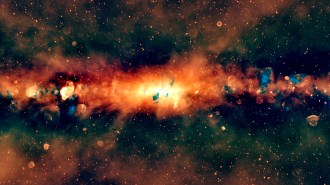WASHINGTON — A new panoramic view of the universe portrays the assembly of galaxies over 12 billions years of cosmic history, depicting that buildup over a wide range of wavelengths with unprecedented sharpness and depth. The farthest galaxies in the compiled image date from a time when the 13.7-billion-year-old universe was less than 1 billion years old, while the closest galaxies emitted their starlight 12 billion years later.

Astronomers hope to use the image, a mosaic stitched together from images taken by two cameras on the Hubble Space Telescope, as a Rosetta stone for understanding the growth of galaxies.
The panorama captures some 7,500 galaxies ranging from fledgling, irregularly shaped collections of baby stars to the fully formed spiral and elliptical galaxies that are common in the universe today, said Rogier Windhorst of Arizona State University in Tempe. Windhorst and his colleagues unveiled the image at the winter meeting of the American Astronomical Society.
“If you look hard enough, you can find a galaxy of almost any shape,” he said January 5 during a press briefing.
Some of the most misshapen, chaotic galaxies (visible in the image as faint red specks) are those that hail from the farthest back in time. The closest, most mature galaxies, which lie in the foreground of the image, are seen as they appeared just 1 billion years ago.
The new mosaic also shows that smaller galaxies began forming most of their stars considerably later than more massive galaxies, a trend previously noted in images taken only in visible-light. But the new image, which combines several ultraviolet and infrared views taken last fall with the Hubble Space Telescope’s newly installed Wide Field Camera 3 with visible-light images recorded in 2004 by Hubble’s Advanced Camera for Surveys, puts that scenario on surer footing.
The mosaic also reveals that massive elliptical galaxies, long considered “red and dead” because their reddish color indicates that they stopped forming stars long ago, do show some faint, new stars at their cores, noted by a bluish tinge.
Large and data-rich, the zoomable picture stretches about one-third the diameter of the full moon as seen on the sky. Even the 20-foot version of the image displayed in one of the meeting halls doesn’t do it justice, Windhorst said.
In the image, ultraviolet light from hot, young stars is shown in blue; visible, orange light reveals the final stage of the construction of massive galaxies about 8 to 10 billion years ago; and infrared light, shown in red, comes primarily from the most remote galaxies.







